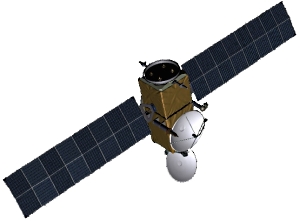
Geosynchronous communications satellite
Satellite broadband internet service transmits and receives signals between a ground dish antenna and a geosynchronous satellite. The dish antenna, similar to that used for satellite TV, is connected to a network router or modem. A geosynchronous satellite orbits the Earth with a period equal to the Earth's rotational period and therefor appears motionless, at a fixed position in the sky, to ground observers.
The advantages of satellite internet service is that it can provide broadband Internet access to people in rural areas where they may have no other choice, and (with some providers) it can provide a mobile Internet connection.
The main disadvantages of satellite internet service is the high latency (delay time required for the signal to travel to and from the satellite, which may be at an altitude of 22,236 miles) which may be up to one second, and the signal interference caused by inclement weather and high sunspot activity.
Other disadvantages are the need to install the satellite dish, which is typically between 30 and 48 inches in diameter, and which must be accurately pointed to the satellite. Also, in order to ensure that all subscribers have good access to the service, satellite Internet providers will throttle bandwidth to lower data rates after a certain download threshold is reached.
More Networking Basics:
• Home and Small Office Networking Guide
• Workgroups and Domains
• Definition: Cloud Computing
• Satellite Broadband Internet Service
• Virtualization For Dummies Cheat Sheet
• Bluetooth in Brief
• Cable Broadband Internet Service
• Network+ Certification Exam Tutorial - How And When To Use Virtual LANs (VLANs)
• Servers - Racks, Blades and Towers
• Networking Foundation Topic - Routing

